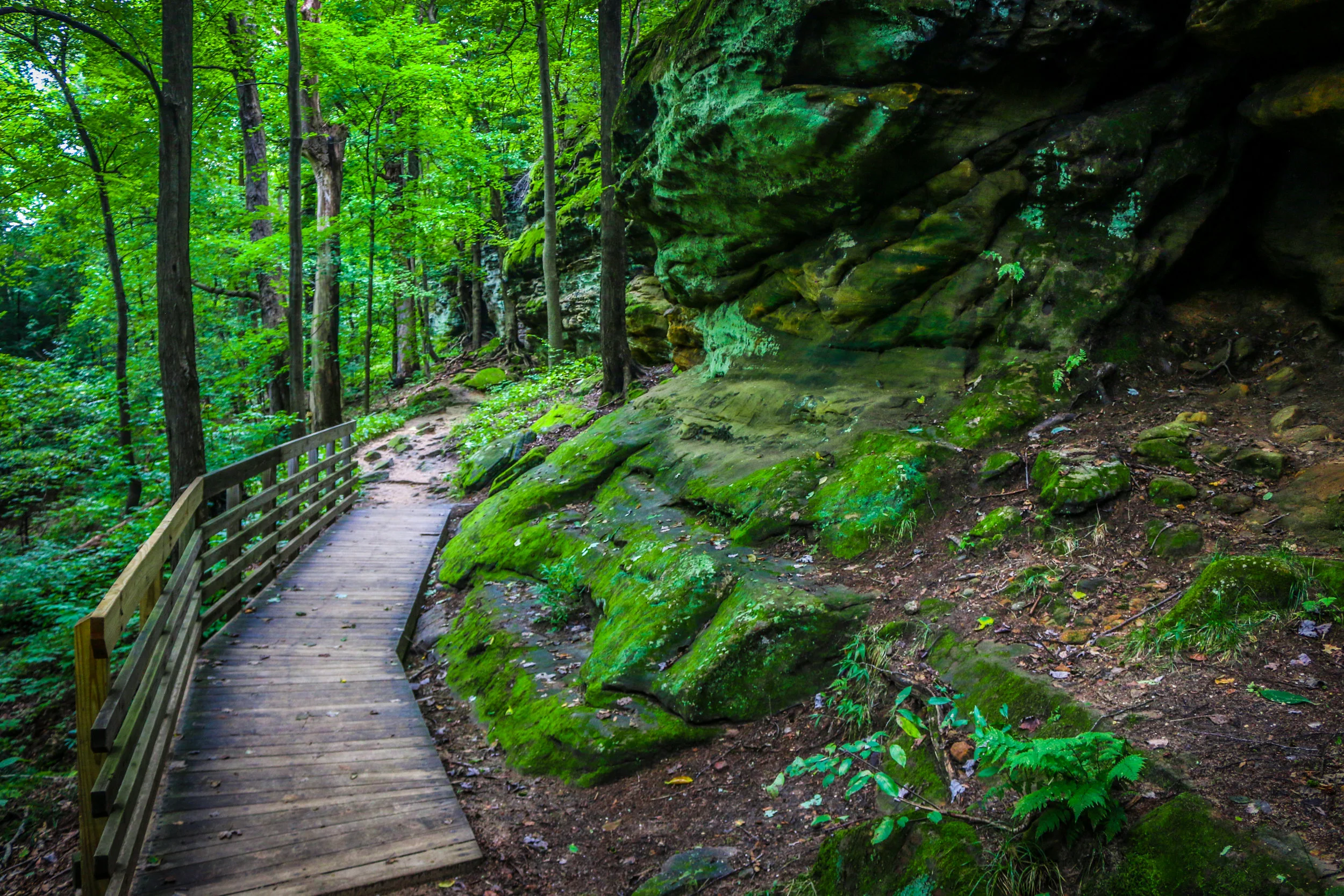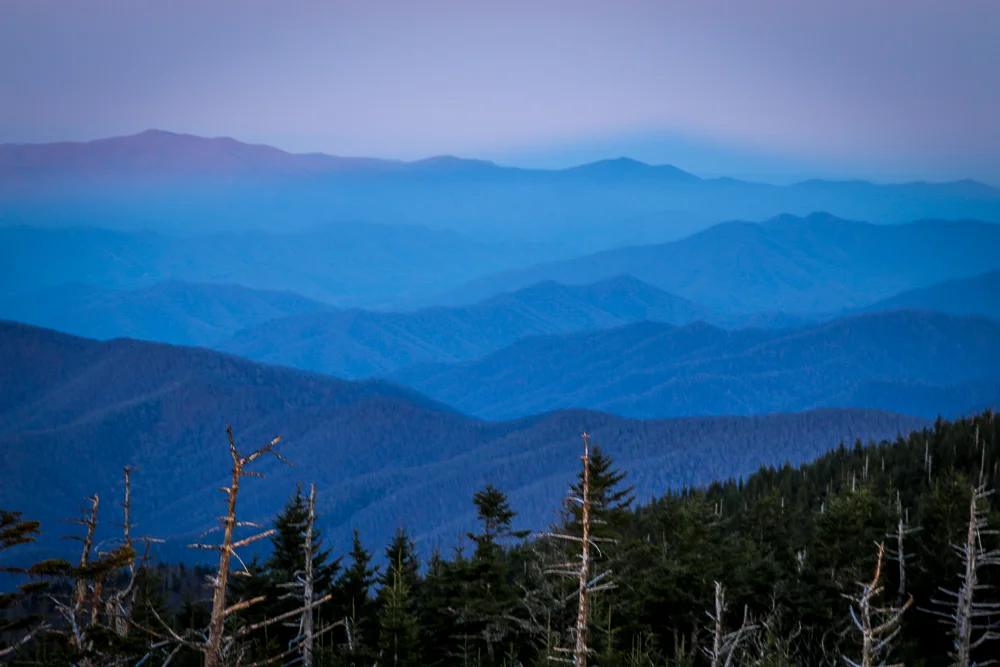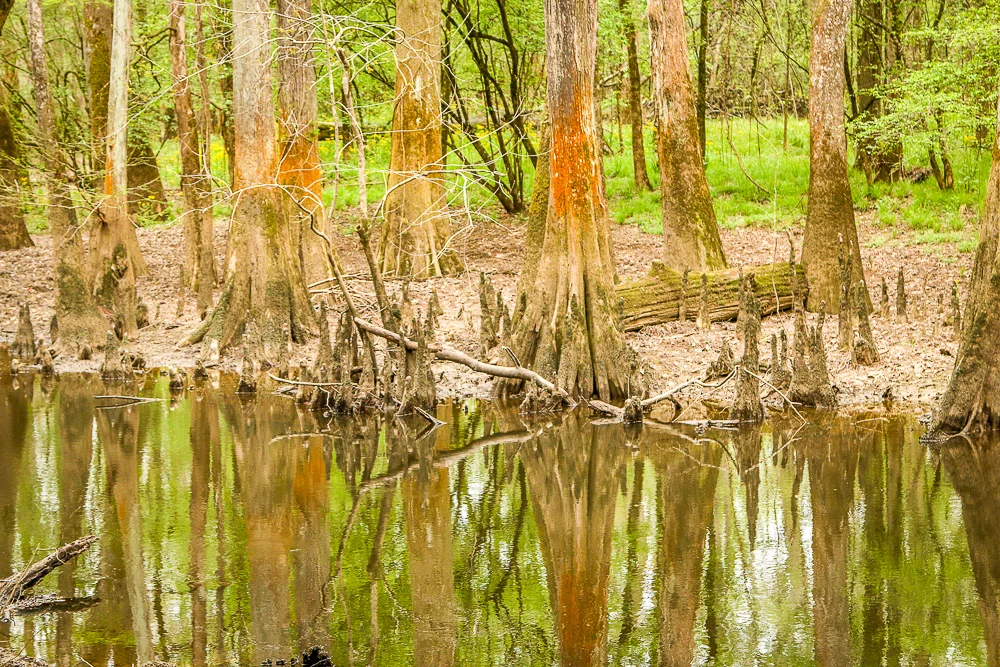Little River Canon National Preserve is a beautiful park in Northeast Alabama. It is a fascinating place because the river runs along the ridge of flat-topped Lookout Mountain which is a clear indicator of how much the landscape must have changed over time. It is one of the deepest canyons in the east, reaching depths of up to 600 feet. The river itself is powerful and incredibly clean and clear due to its high location and the accompanying lack of pollutants. Waterfalls can be found throughout the park, as can stunning views up and down the canyon itself. There are several short but steep hiking trails which lead from the canyon rim down to the river and can definitely give you a good workout. After a long day of hiking and taking photos, I took my last walk down the Eberhart Trail at the end of the scenic drive. When I got to the river I took a quick dip in the cold refreshing water which instantly washed away the fatigue of the day and left me with a smile on my face. It was a wonderful day and I hope you enjoy the photos I took in beautiful Little River Canyon.
Viewing entries in
National Park
These photos come from the Creole plantations located along the Cane River in northeastern Louisiana. Even reading that sentence back makes me smile as it sounds as remarkably Southern as it is. The word “Creole” is a complicated one, as it has evolved over time. Technically it means something which comes from the new world but with old world roots. People born in Louisiana of Spanish and French decent were referred to as “Creoles”. The word also encompassed architecture and food born in the region but using traditional knowledge. Today, it tends to mean people of mixed heritage including those of European, African and Native American descent. Regardless, these early settlers to the region began mostly as subsistence farmers and over time grew into large plantation owners. As cotton became king in the south, many of these plantations got on board, purchasing hundreds of enslaved people to do their manual labor. The plantations grew and thrived. After the Civil War and the the 13th Amendment to the Constitution freed the slaves, many stayed on as sharecroppers and tenant farmers, as the plantation and cotton were the only things they had ever known. Some of these plantations remained in business into my lifetime owned and worked by generation after generation of people from the same families.
The first photos in this collection come from the Magnolia Plantation, a part of Cane River Creole National Historical Park. Once owned by the LeComte Family, this large plantation was worked by 275 enslaved people in its heyday. While the Big House is still owned by the family and is closed to visitation, the overseer’s house, plantation store, blacksmith shop, cotton gin building and slave cabins are all open to the public as part of the park. I especially enjoyed learning about the “pigeonnier”, a pigeon coup in which their droppings were used as fertilizer and baby pigeons were sometimes eaten as a delicacy. Today only 8 of the original 71 slave cabins remain, but were occupied by plantation workers until 1970. This plantation is fascinating to wander around and learn about the people who lived there…
species of birds, 300 species of fish, 50 species of reptiles and 40 mammal species. Included in these numbers are the endangered Florida panther, and the American crocodile, which is only found in the Everglades. In addition to its National Park status, the Everglades is a UNESCO World Heritage Site and part of the International Biosphere Reserve. It’s a remarkable place.
I have visited the Everglades many times, and always enjoyed myself there. There are always alligators out and about and hundreds upon hundreds of birds. On this visit I went in the east entrance all the way to the beautiful boat harbor at Flamingo, across the Tamiami trail, and down to Everglades City and the 1000 Islands as well. I was hoping to do an overnight kayaking trip, but the weather was threatening, so that will have to wait until next time. While it was fairly dry during my visit, the area will get extremely wet during the frequent summer rainstorms. I prefer the less buggy winter months though. I love getting out and doing airboat rides in the Everglades, and my favorite place to do them from is Everglades Alligator Farm outside the east entrance. To be fair though, I’ve gone with half a dozen different companies in my life, and never had a bad airboat ride. Inside the park, I particularly liked the Anhinga and Gumbo Limbo Trails near the east entrance. They have lots of wildlife and some pretty awesome trees to check out as well. The trails were flat and pretty easily accessible as well.
I hope you enjoy these photos from the Everglades, and I hope you can get out and explore them for yourself…
It isn’t easy getting to Dry Tortugas National Park, but it is definitely worth it. Located just under 70 miles from Key West, you either need to take a boat or a plane to visit the park, but once you arrive, you can’t help but love the isolation. The Spanish, under Ponce de Leon, gave the islands the name Tortugas (Spanish for “turtles”) because of the abundance of this important food source in the area. The British called them the Dry Tortugas to indicate there was no fresh water to be found there. More recently, it became the site of Fort Jefferson and an important lighthouse which helped guide ships making their way through the channel into the Gulf of Mexico. It may seem like a strange place for a fort, but it is at the very end of Florida’s massive barrier reef, which is the third longest barrier reef in the world. Big ships have to come this far south to get around the bottom of the state. The United States started building this fort just a few years after buying Florida from Spain in order to protect the important shipping lane connecting the Mississippi River to the world.
During the Civil War, the fort remained in Union hands, and helped enforce the embargo on the Confederate southern coast. After the Civil War, the fort was used as a prison, Its most famous inmate was Dr. Samuel Mudd, the doctor who had treated John Wilkes Booth after he assassinated Abraham Lincoln. After a yellow fever outbreak in which Dr. Mudd helped treat the sick, he earned a pardon from President Andrew Johnson. The fort would once again serve a military purpose during the Spanish/American War in 1898, and had served as a resupply point for the U.S.S. Maine before her fateful voyage to Cuba. Franklin Roosevelt designated Fort Jefferson National Monument in 1935, and the entire area was re-designated as Dry Tortugas National Park in 1992.
Biscayne National Park is a remarkable area in far south Florida, protected for its “rare combination of terrestrial, marine and amphibious life in a tropical setting of great natural beauty”. It is remarkable among National Parks as 95% of the park is covered by water. The coral reef which is protected within these waters is part of the third longest barrier reef system in the world. A part of that reef became exposed long ago, forming the barrier islands on the outer edge of the park. These islands are a part of the Florida Keys, although since they were never connected by rail or highway, they have remained relatively isolated. This isolation does not mean they have not had visitors though. Both John James Audubon and Robert E. Lee visited these outer islands in the 19th century. In the 20th century, the upper keys hosted wealthy businessmen and 5 sitting or future U.S. presidents.
In the fifties, proposals were put forth to develop these upper keys, connect them with a highway to the mainland and build a city to be called Islandia. Thankfully (in my opinion), this development never took place, as a small but vocal group called for protection as a national park instead. Through their efforts,this area became a national monument in 1968, and a national park in 1980…
Hello everyone. I hope y’all have had as good a week as I have. This week, I had a great time finishing out my visit to Georgia traveling to Jekyll Island, the Okefenokee Swamp and Cumberland Island National Seashore. From there, I crossed the border into Florida and have spent a wonderful few days in The Sunshine State, mostly just chilling out and hanging out with one of my best friends. I’m headed home to Washington D.C. for the holidays, and really looking forward to a few days off the road. It’s time to recharge my batteries, fill up on Christmas cookies and good cheer and catch up with my family and friends for a few days. I haven’t always been able to make it home for Christmas over the years, so I’m grateful to have that opportunity this year.
After we met last week, I spent Thursday on beautiful Jekyll Island, just south of Brunswick. One of my very good friends who I used to work with on St. Thomas, had lived and worked on Jekyll for a while, and gave me all kinds of great places to visit while I was there. I started with a walk out to somewhere she referred to as “bird pond”, although I don’t think it actually had a name. There were a ton of pretty birds there though, so I can see why she would call it that. The area I parked in to make the walk was beautiful as well, with amazing oak trees draped in Spanish moss. From there I made my way out to Driftwood Beach, stopping to see some cool old tabby ruins from some of the island’s earliest settlers on the way. Driftwood Beach was a beautiful beach on the north side of the island which was covered by massive dead trees and, obviously, driftwood. It was awesome and I had a wonderful walk up and down the beach, spotting tons of birds along the way…
I first went to Cumberland Island National Seashore now almost 30 years ago. We went on our 8th Grade class trip on a tour that included Charleston and Savannah, and perhaps our favorite at the time, Kings Dominion amusement park near Richmond. I’ve often thought about Cumberland Island and how much I wanted to go back. Since I was there, I’ve visited 320 or so units of the National Park Service, but Cumberland Island has eluded me. Because you have to get there and back by ferry, it takes more than a few hours of commitment and at least enough planning ahead time to make a ferry reservation. But finally I made it back to the wild island off the coast of Georgia, and it was spectacular. One of my friends asked if it was as beautiful as she remembered and I told her one of the most beautiful things about a National Park site is that it doesn’t change much - that is, in fact, the whole idea! So while I am older and bigger and perhaps a touch wiser, Cumberland Island is much the same…
Mammoth Cave is the longest known cave system in the world. So far, over 400 miles of cave have been explored and mapped and nobody can really say how much further the cave goes. It is generally a dry cave, so it’s not known for beautiful and elaborate formations (with some notable exceptions), but it’s enormous rooms and passageways make it a magical place to visit. It is a National Park, a UNESCO World Heritage Site and part of the International Biosphere Reserve.
In addition to the vast underground cave system, the park also protects 52,000 acres of beautiful Kentucky forest surrounding the Green River. Miles and miles of trails crisscross the park providing ample opportunities for exploration above ground as well…
It’s been a great week out here in North Central Ohio. Even though I haven’t gone very far, I’ve been seeing a lot of cool things and spent the entire weekend at the Little C Music Festival in Canton. The weather has warmed up again, but the days are starting to get noticeably shorter. The first hints of fall are starting to show up in the natural world, with more obvious ones like pumpkins at the stores and Halloween shops opening in the man-made one. I love the fall and am very happy to welcome the cooler weather and beautiful changing colors. It means warm apple cider and campfires and that all of my favorite holidays are right around the corner. I’ve had a great summer, but I am definitely ready for the change of season.
My week started with a second great day in Cuyahoga Valley National Park. I enjoyed a few walks in the park including out to Blue Hen Falls, one in The Ledges area and another through the Beaver Marsh. The weather was a bit overcast that day…
Cuyahoga Valley National Park, located in north-central Ohio between Cleveland and Akron, is a wonderful place to visit. There are several beautiful natural areas to see including The Ledges, a series of moss covered rock cliffs, and the Beaver Marsh, a restored wetland teeming with wildlife. Several beautiful waterfalls can be found within the park boundaries, most notably powerful Brandywine Falls and graceful Blue Hen Falls. Cuyahoga Valley National Park also preserves some wonderful history with a restored section of the Erie and Ohio Canal and excellent interpretations of canal life and travel. Some of the surrounding towns are full of charming buildings and make pleasant detours.
A friend of mine recently passed through Cuyahoga Valley National Park and commented to me that it wasn’t worthy of the National Park title. At first glance, I might have agreed with him but I really warmed up to the area during the two days I spent there. Having grown up in an east coast city…
Our National Parks are our greatest treasure here in the United States. They are magical places which thankfully our forefathers had the foresight to set aside in perpetuity for their children and our children and their children. They preserve some of our most amazing landscapes and ecosystems and protect all manner of flora and fauna. From the Everglades in Florida to Denali in Alaska, even the names call forth wildness in our imaginations. Have no doubt, these are our lands, and if we want to keep them that way, we need to protect them. But most of all, we need to enjoy them. This is the second post in a series I have titled In Focus, which will take a look deeper into our National Parks. These are primarily photography posts, trying to show you the beauty of our parks and take you inside of them with me. My hope is that you will get out and see them for yourself. After all, they belong to you too.
America's National Parks are our nation's most valuable resources. From the U.S. Virgin Islands to the coast of Maine and from Alaska to the South Pacific and so many amazing places in between, the National Park System protects our most treasured natural and cultural areas. There are many different designations within the system, from National Battlefields and Historic Sites to National Monuments and Heritage Areas, but none is more revered than the National Parks. Of the 420 or so sites withing the system, only about 60 have the designation of National Park. Over the course of many years, I've had the distinct pleasure of seeing almost all of them. They are all incredible places and I can't imagine my life without being able to visit these areas again and again. While sometimes the topic will come up in the news about "government owned land", we must remember that this is actually public land - our land. And it's there for us to enjoy and will be forever as long as we don't let our guard down.
Congaree National Park in central South Carolina is one of our newest National Parks, having received that designation in 2003. It protects the largest tract of old growth, bottomland hardwood forest left in the United States...













